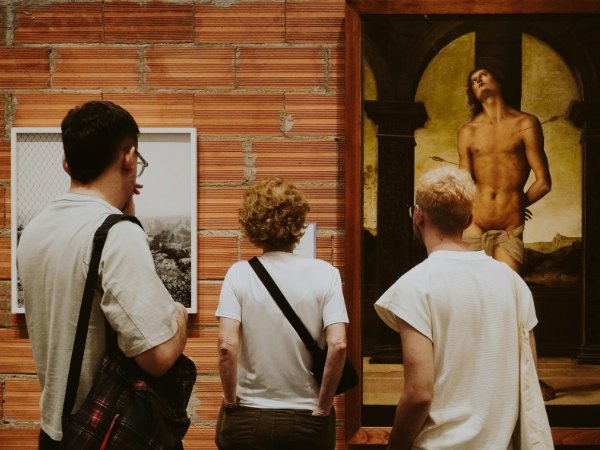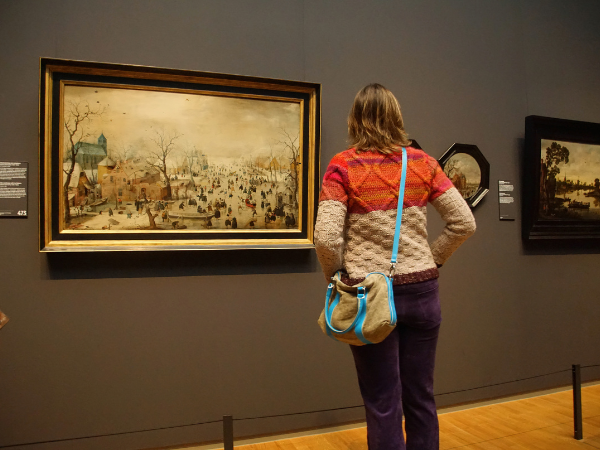Vincent Van Gogh’s “Sunflowers” is one of the most famous art pieces in history. This collection of vibrant paintings showcases the beauty of sunflowers in various stages of life.
Van Gogh created these works in the late 1880s while living in Arles, France. They reflect his deep connection to nature and his unique style. The bold colors and striking details draw viewers in, evoking strong emotions. Each painting tells a story, capturing the essence of the flowers and the artist’s state of mind.
“Sunflowers” represents hope and warmth, making it a favorite among art lovers. Understanding these paintings offers insight into Van Gogh’s life and artistic journey. Discover the magic behind this iconic series.
Vincent Van Gogh’s Life
Vincent van Gogh is one of the most famous artists in history. His work, especially the series of paintings featuring sunflowers, captures the beauty of nature. Van Gogh’s life was filled with struggles and passion. Understanding his life helps us appreciate his art even more. Let’s explore his early years and artistic journey.
Early Years
Vincent van Gogh was born on March 30, 1853, in the Netherlands. His family was not wealthy, but they valued education and art. Vincent had a close relationship with his brother, Theo, who supported him throughout his life.
Some key points about his early life:
- Vincent was the eldest of six children.
- He worked at an art dealership at a young age.
- His first artistic influence came from his uncle, a successful art dealer.
- Vincent struggled with depression and anxiety during his youth.
Despite early challenges, he found solace in art. He began to draw and paint more seriously in his late twenties. His early works focused on peasant life and landscapes. They often depicted the harsh reality of life. Below is a table summarizing his early influences:
| Influence | Description |
|---|---|
| Family | Strong support, especially from brother Theo. |
| Art Dealers | Experience in the art world helped shape his vision. |
| Nature | Inspiration from the rural Dutch landscape. |
Artistic Journey
Vincent van Gogh’s artistic journey began earnestly in the late 1880s. He moved to Paris, where he met other artists. This city opened new doors for his creativity. He became friends with artists like Henri Toulouse-Lautrec and Paul Gauguin.
His style evolved rapidly. Van Gogh experimented with colors and brushwork. He used vibrant colors and bold strokes to express emotions. Some key points about his artistic journey:
- He created over 2,100 artworks.
- His most famous works include “Starry Night” and “Sunflowers.”
- He struggled with mental health issues, which influenced his art.
- He only gained fame after his death.
Vincent’s “Sunflowers” series is a perfect example of his unique style. These paintings show his love for color and light. They highlight the beauty of simple subjects. His artistic journey reflects both his struggles and his passion for art.
The Significance Of Sunflowers
The significance of sunflowers in Vincent Van Gogh’s work goes beyond their bright colors. These flowers represent hope, warmth, and beauty. Van Gogh painted several sunflower series, each filled with emotion and meaning. His use of sunflowers reflects his inner feelings and thoughts. Understanding their symbolism helps us appreciate his art more deeply.
Symbolism In Art
Sunflowers have rich symbolism in art. They often represent positivity and warmth. Van Gogh’s choice of sunflowers was intentional. He saw them as a symbol of friendship and happiness.
In Van Gogh’s paintings, sunflowers convey different themes:
- Joy: Bright yellow petals symbolize happiness.
- Life: They represent the beauty of life and nature.
- Transience: Their short lifespan reminds us of life’s fleeting moments.
Van Gogh’s sunflowers also reflect his personal struggles. The contrast between vibrant colors and dark backgrounds shows his emotional state. Below is a table that highlights the key meanings of sunflowers in his art:
| Symbol | Meaning |
|---|---|
| Yellow Petals | Happiness and optimism |
| Seeds | Growth and potential |
| Wilting Flowers | Impermanence of life |
In Van Gogh’s eyes, sunflowers were not just flowers. They were a medium to express his feelings. Their presence in his paintings invites viewers to reflect on their own emotions.
Cultural Impact
Sunflowers have a significant cultural impact, especially due to Van Gogh’s influence. His sunflower paintings are among the most recognized artworks in the world. They inspire artists and art lovers alike.
Van Gogh’s art has led to several cultural movements:
- Impressionism: His bold colors and brush strokes inspired many.
- Post-Impressionism: Van Gogh helped shape this movement with his unique style.
- Modern Art: Many modern artists cite Van Gogh as an influence.
Sunflowers also play a role in various cultural traditions:
- Festivals: Celebrations often feature sunflowers.
- Symbol of Peace: They are used in peace movements.
- Art Exhibitions: Van Gogh’s sunflowers are displayed worldwide.
Overall, the cultural significance of sunflowers transcends art. They connect people to emotions, nature, and history. Van Gogh’s legacy continues to shine through these bright blooms.
Artistic Techniques
Vincent Van Gogh’s “Sunflowers” series stands out in the art world. His artistic techniques create a unique feel and emotional impact. Each brushstroke and color choice tells a story. Understanding these techniques deepens appreciation for his work.
Brushwork
Van Gogh’s brushwork is a key part of his style. He used thick, short strokes to create texture and movement. This technique adds energy to the paintings. The brushwork feels alive, drawing viewers in.
Some notable aspects of his brushwork include:
- Impasto Technique: He applied paint thickly, making the surfaces textured.
- Directional Strokes: Strokes follow the curves of the flowers, enhancing their shapes.
- Expressive Movement: Each stroke conveys emotion, reflecting Van Gogh’s feelings.
Here is a summary of Van Gogh’s brushwork techniques:
| Technique | Description |
|---|---|
| Impasto | Thick paint application for texture |
| Directional Strokes | Strokes that follow the subject’s form |
| Expressive Movement | Strokes that convey emotional depth |
This brushwork technique makes “Sunflowers” vibrant and dynamic. It invites viewers to feel the energy and emotion within each piece.
Color Palette
Van Gogh’s color palette in “Sunflowers” is striking and bold. He used bright yellows, deep greens, and rich browns. These colors create a warm and inviting atmosphere. They evoke feelings of happiness and vitality.
Key elements of his color choices include:
- Vivid Yellows: Different shades of yellow represent the sun and life.
- Complementary Colors: Greens and browns enhance the yellows, adding depth.
- Emotional Impact: The colors reflect Van Gogh’s mood and emotional state.
Below is a breakdown of the colors used:
| Color | Emotion/Effect |
|---|---|
| Bright Yellow | Joy and warmth |
| Deep Green | Natural balance |
| Rich Brown | Grounding and stability |
The color palette enhances the overall impact of “Sunflowers.” It reflects Van Gogh’s unique vision and emotional depth. The colors invite viewers into a world filled with light and warmth.
Famous Sunflower Paintings
Vincent Van Gogh’s famous sunflower paintings are iconic in the art world. They capture the beauty and vibrancy of sunflowers. These artworks show his love for nature and his unique style. Each painting tells a story. Van Gogh used bold colors and expressive brush strokes. His sunflowers have become symbols of joy and warmth.
First Series
The first series of Van Gogh’s sunflower paintings was created in 1888. He painted them while living in Arles, France. This series includes five paintings. They are known for their bright yellow tones and dynamic compositions. Van Gogh wanted to decorate his friend Paul Gauguin’s room with these flowers.
Key features of the first series:
- Bright yellow and golden colors
- Different stages of sunflower growth
- Each painting has a unique background
| Painting Title | Year | Location |
|---|---|---|
| Sunflowers (Vase 1) | 1888 | Private Collection |
| Sunflowers (Vase 2) | 1888 | National Gallery, London |
| Sunflowers (Vase 3) | 1888 | Van Gogh Museum, Amsterdam |
| Sunflowers (Vase 4) | 1888 | Philadelphia Museum of Art |
| Sunflowers (Vase 5) | 1888 | State Pushkin Museum, Moscow |
Each piece in this series shows Van Gogh’s emotional connection to the flowers. The sunflowers seem alive. They reflect his passion and energy. This series set the stage for the next set of sunflower paintings.
Second Series
The second series of sunflower paintings was created in 1889. Van Gogh painted these in Saint-Rémy-de-Provence. He focused on the beauty of sunflowers again but in a different style. These paintings are more expressive and deeper in color. The sunflowers now show a mix of yellow and orange tones.
Features of the second series:
- Deeper, more vibrant colors
- Fewer flowers, more focus on detail
- More expressive brush strokes
| Painting Title | Year | Location |
|---|---|---|
| Sunflowers (Vase 1) | 1889 | Kröller-Müller Museum, Netherlands |
| Sunflowers (Vase 2) | 1889 | Van Gogh Museum, Amsterdam |
In this series, Van Gogh captured the fading beauty of the flowers. They reflect the passage of time. The sunflowers look more fragile yet still vibrant. These paintings highlight the artist’s skill and emotional depth.
Influence On Modern Art
Vincent Van Gogh’s “Sunflowers” has left a deep mark on modern art. The vibrant colors and bold strokes are unforgettable. These paintings show more than just flowers. They express emotions and ideas. Many artists today draw inspiration from Van Gogh’s unique style. His influence can be seen in various art forms around the world.
Legacy Of Van Gogh
Van Gogh’s legacy is vast and powerful. His “Sunflowers” series is a key part of this legacy. It changed how people view art. Here are a few important points about his impact:
- Emotional Expression: Van Gogh used color and brushwork to show feelings.
- Post-Impressionism: He helped shape the Post-Impressionist movement.
- Breaking Traditions: He broke away from traditional forms and subjects.
- Art for All: His works made art accessible to everyone.
His style inspired many modern artists. They admire his ability to convey emotion through simple subjects. The use of bright colors and bold lines opened new doors for creativity.
Here’s a quick look at Van Gogh’s influence:
| Aspect | Impact |
|---|---|
| Color Use | Inspired colorful palettes in modern art. |
| Brush Techniques | Encouraged expressive and dynamic brushwork. |
| Subject Matter | Promoted everyday objects as art subjects. |
Inspiration For Artists
Many artists find inspiration in Van Gogh’s work. His “Sunflowers” series encourages creativity. The bold colors and expressive forms speak to artists today.
Here are ways Van Gogh inspires modern creators:
- Emotional Depth: Artists learn to express their emotions.
- Nature Themes: Many focus on flowers and landscapes.
- Experimentation: Artists feel free to try new techniques.
Van Gogh’s influence goes beyond painting. Writers, musicians, and filmmakers also draw from his themes. The quest for beauty and emotion resonates in many forms. His work continues to spark discussions about art’s role in society.
In summary, Van Gogh’s “Sunflowers” is not just art. It is a source of inspiration. It encourages artists to explore their feelings and creativity.
Conclusion
Sunflowers by Vincent Van Gogh capture beauty and emotion. These paintings show his love for nature. Bright yellows and bold strokes create a lively feeling. They remind us of warmth and joy. Van Gogh’s sunflowers tell a story of hope and life.
Each flower holds its own meaning. They continue to inspire artists and fans alike. Sunflowers remain a symbol of positivity and resilience. Enjoying Van Gogh’s work brings a sense of peace. His art lives on, touching hearts around the world.
Embrace the beauty of sunflowers in your life today.




